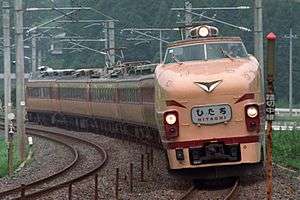301 series
| 301 series | |
|---|---|
|
Set K5, February 2003 | |
| In service | 1966–2003 |
| Manufacturer | Kawasaki Heavy Industries, Nippon Sharyo |
| Constructed | 1966–1969 |
| Scrapped | 2003 |
| Number built | 56 vehicles |
| Number in service | None |
| Number preserved | 1 vehicle |
| Formation | 10 cars per trainset (originally 7 cars) |
| Fleet numbers | K1–5 |
| Operator(s) |
JNR (1966-1987) JR East (1987-2003) |
| Depot(s) | Mitaka |
| Line(s) served | Chūō-Sōbu Line, Eidan Tōzai Line |
| Specifications | |
| Car body construction | Aluminium |
| Car length | 20 m (65 ft 7 in) |
| Doors | 4 pairs per side |
| Maximum speed | 100 km/h (60 mph) |
| Electric system(s) | 1,500 V DC |
| Current collection method | Overhead catenary |
| Safety system(s) | ATS-B/P, ATC |
| Track gauge | 1,067 mm (3 ft 6 in) |
The 301 series (301系) was an electric multiple unit (EMU) train type introduced in 1966 by Japanese National Railways (JNR), and later operated by East Japan Railway Company (JR East) on Chūō-Sōbu Line and Tōzai Line subway through-running services in Tokyo, Japan, until 2003.[1]
Design
Broadly based on the 103 series commuter EMU,[1] the 301 series was designed specifically for use on through-running services with the Eidan Tōzai Line (present-day Tokyo Metro Tōzai Line) in Tokyo, and was the first aluminium-bodied rolling stock introduced on Japanese National Railways (JNR).[2]
When first delivered, the sets were finished with a clear acrylic paint, giving an unpainted appearance.[1] The sets were subsequently painted in light grey with a yellow bodyside stripe.[1] This was later changed to a light blue ("Blue No. 22") stripe to match the Tōzai Line line colour.[1][3]
For cost reasons, only 56 vehicles were built, and subsequent rolling stock built for Tōzai Line through-running services was conventional steel-bodied 103-1200 series stock.[1]
Operations
The 301 series trains were based at Mitaka Depot in Tokyo throughout their service life, and were used on Chūō-Sōbu Line local and Tōzai Line subway through-running services.[3]
Formations

Following reforming into 10-car sets, the fleet was formed as follows, with car 1 at the Nishi-Funabashi end and car 10 at the Mitaka end. Sets K1 and K2 included former KuHa 301 and KuMoHa 300 driving cars with driving cab equipment removed.[3]
Sets K1–2
| Car No. | 1 | 2 | 3 | 4 | 5 | 6 | 7 | 8 | 9 | 10 |
|---|---|---|---|---|---|---|---|---|---|---|
| Designation | Tc | M | M' | M | M'c | Tc | M | M' | M | M'c |
| Numbering | KuHa 301 | MoHa 301 | MoHa 300 | MoHa 301 | KuMoHa 300 | KuHa 301 | MoHa 301 | MoHa 300 | MoHa 301 | KuMoHa 300 |
Cars 2, 4, 7, and 9 were each equipped with one lozenge-type pantograph.[3]
Sets K3–5
| Car No. | 1 | 2 | 3 | 4 | 5 | 6 | 7 | 8 | 9 | 10 |
|---|---|---|---|---|---|---|---|---|---|---|
| Designation | Tc | M | M' | M | M' | T | M | M' | M | M'c |
| Numbering | KuHa 301 | MoHa 301 | MoHa 300 | MoHa 301 | MoHa 300 | SaHa 301-100 | MoHa 301 | MoHa 300 | MoHa 301 | KuMoHa 300 |
Cars 2, 4, 7, and 9 were each equipped with one lozenge-type pantograph. SaHa 301-101 was modified from former MoHa 301-4, and retained the original pantograph mounting points.[3]
Interior
Seating consisted of longitudinal bench seating throughout. Compared with the 103 series seating, seat width was increased by 50 mm to 550 mm per person.[1]
History
The 301 series were delivered in 1966 to Mitaka Depot in Tokyo,[1] initially formed as eight 7-car sets.[4] From 1981, the fleet was reformed into 10-car sets with the creation of SaHa 301 trailer cars converted from former MoHa 300 and MoHa 301 motored cars.[1]
As of 1 April 2002, 50 vehicles (5 x 10-car sets) remained in service,[5] but the fleet was subsequently replaced by new E231-800 series EMUs and withdrawn during 2003.[4]
A special Sayonara 301 series train was run by JR East on 3 August 2003.
Preserved examples

Driving car KuMoHa 300-4 of set K2 is stored at JR East's Omiya Works.
References
| Wikimedia Commons has media related to JNR 301. |
- 1 2 3 4 5 6 7 8 9 JR全車輛ハンドブック'92 [JR Rolling Stock Handbook 1992]. Japan: Neko Publishing. 1992. p. 241.
- ↑ "川崎車輌時代1928年(昭和3年)〜1968年(昭和43年)" [Kawasaki Rolling Stock era 1928-1968]. K Train Express (in Japanese). Japan: Kawasaki Heavy Industries. Archived from the original on 26 March 2010. Retrieved 29 June 2012.
- 1 2 3 4 5 JR電車編成表 '98夏号 [JR EMU Formations - Summer 1998]. Japan: JRR. July 1998. p. 78. ISBN 4-88283-029-9.
- 1 2 "JR301系" [JR 301 series]. Tetsudo Hobidas (in Japanese). Japan: Neko Publishing Co., Ltd. February 2008. Retrieved 29 June 2012.
- ↑ JR電車編成表 '02夏号 [JR EMU Formations - Summer '02]. Japan: JRR. June 2002. ISBN 4-88283-037-X.
